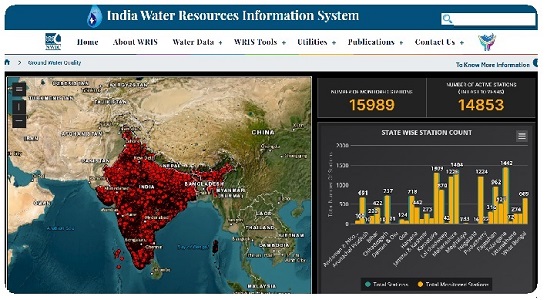Central Ground Water Board has 16 Regional Chemical Laboratories to carry out chemical analysis of water samples. The Chemical laboratories are well equipped with sophisticated instruments like ICP-MS, Atomic Absorption Spectrophotometer (AAS) etc. Ground water sampling for quality monitoring is done once a year during the premonsoon period. In addition to it ground water samples are also collected and analysed as a part of other scientific studies.
| Report / Dataset | Link to Download |
|---|---|
| Ground Water Quality Data - 2023 | Click to Download |
| Ground Water Quality Data - 2022 | Click to Download |
| Ground Water Quality Data - 2021 | Click to Download |
| Ground Water Quality Data - 2020 | Click to Download |
| Ground Water Quality Data - 2019 | Click to Download |
| Status of Ground Water Quality in Coastal Aquifers of India | Click to Download |
| Geogenic Contamination of Ground Water | Click to Download |
| Uranium Occurrence in Shallow Aquifers in India | Click to Download |
| Ground Water Quality Issues and Challenges in Punjab | Click to Download |
| Percentage of Samples showing Nitrate above permissible limit in 2019 and 2023 | Click to Download |
 |
|
| Click here to visit India WRIS portal for access to water quality data |
Under NAQUIM, arsenic safe exploratory wells have been constructed in arsenic affected parts of the States of West Bengal, Bihar and Uttar Pradesh. The arsenic safe deeper aquifer zones have been identified and wells have been constructed tapping the arsenic safe deeper aquifers using innovative cement sealing technique. So far, 513 exploratory wells tapping arsenic safe aquifers have been constructed under NAQUIM programme including 40 in Bihar, 188 in West Bengal and 285 in Uttar Pradesh. The innovative cement sealing technique of CGWB has been shared with the state agencies to utilize to construct arsenic free wells. The technique is most effective in the alluvial terrains in parts of Bihar, Uttar Pradesh and West Bengal where hydrogeological conditions favour construction of such wells. Successful implementation of the technique requires domain expertise in identifying and locating suitable clay zones that separate arsenic safe aquifers from the contaminated ones so that cement sealing can be placed against these impervious zones. The State Water Supply Agencies of Uttar Pradesh and West Bengal have applied the cement sealing technique. States of Uttar Pradesh and West Bengal have constructed nearly 1450 such wells catering to the drinking water requirements of nearly 70 lakh persons.
| Construction of Arsenic Safe Wells using Cement Sealing Technique |












